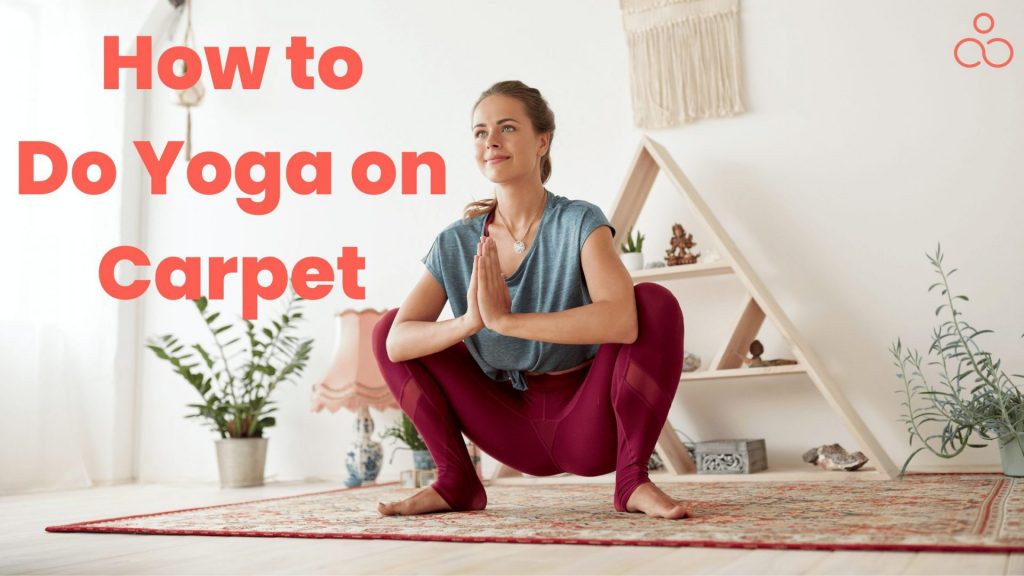Ever wonder how to do yoga on carpet? There are so many benefits to practicing yoga that it’s no surprise that people are looking for ways to do it in more comfortable places, like their own homes. It’s easier than ever to squeeze in a relaxing yoga session even on the busiest days. So is it safe to practice yoga on a carpet without a mat? The answer is yes! With a few easy tips, you can find out how to do yoga on a carpet from the best comfort of your home.
In this article, we will discover all aspects of carpet yoga, several pros and cons of doing yoga on the carpet, and some expert tips to ensure a fruitful yoga practice on this soft surface.
How to do yoga on carpet without a mat? Is it safe?
The best place to practice yoga isn’t on a carpeted floor. However, it can provide extra cushion and comfort for simple sitting practices and help you strengthen your core engagement in some postures.
You can use a mat or skip it when practicing yoga on a carpet. In the latter case, you run a high risk of slipping and possibly injuring yourself due to the lack of grip.
A carpet can be a temporary solution if you don’t have a yoga mat but want to do yoga.
Here are my top tips on practicing yoga on a carpet without risking injuries.
Avoid fast flows
Cardio yoga flows and fast-flowing Vinyasa poses shouldn’t be practiced on a slippery carpet surface. With a stable surface beneath your feet, you can maintain your balance and avoid losing yourself and becoming dissatisfied and demotivated when practicing yoga.
Stick to gentle sitting and standing postures
A carpeted floor is the ideal surface for gentle sitting and standing stretches. If you practice on a soft carpet, your joints will remain healthy, and you’ll feel cozy and comfortable. Stretching on a soft fluffy carpet is likely surpassed only by yoga in bed.
Do practice balance poses, but don’t push them
The softness of the carpet can provide a unique challenge to the small muscles in your feet and the stabilizing muscles in areas you may not normally exercise. Make sure to choose yoga poses that you feel completely confident performing instead of attempting to challenge your balance.
Use a wall
When practicing yoga without a mat, utilizing a wall is highly recommended. It can improve your balance and aid in adjusting certain poses that may be uncomfortable on a carpet, such as Downward Facing Dog.
The Pros & Cons of Practicing Yoga on a Carpet
Why practice on a carpet? Carpets are a good alternative to traditional yoga mats. If you’re looking for a challenge, practicing yoga on a carpet can be an excellent way to engage your muscles as they are required to work harder to maintain stability, as opposed to using a sticky yoga mat.
Let’s examine some pros and cons of practicing yoga on a carpet:
| PROS | CONS |
| Soft carpets offer cushioning for your body, easing joint pressure. | Balancing poses on carpet can be difficult and risky due to insufficient support, potentially causing injuries. |
| It’s warmer compared to hard surfaces like wood, providing comfort in colder months. | Performing yoga on a carpet may result in friction burns, scratches, or irritated skin. |
| Carpet yoga demands more muscle effort due to less traction, enhancing strength. | Uneven carpet surfaces can cause discomfort from bumps and uneven spots pressing on your body. |
| No defined mat shape allows for more exploration and freedom in your practice. | Practicing on carpets can be unhygienic, affecting air quality and your mood with musty or dirty conditions. |
| For a challenge, the increased balancing difficulty can improve your yoga skills. | Sweat and body oils get absorbed into the carpet, necessitating more frequent cleaning. |
| Practicing on the carpet is better than not practicing yoga at all. | Consistent practice in the same spot may wear out or damage your carpet. |
How do you stabilize a yoga mat on a carpet? Find out some quick solutions
If you’re trying to do yoga on a carpet, you know how frustrating it can be to have your mat slip or bunch up on you. Fortunately, there are several ways to stabilize your yoga mat on a carpet. Here are some quick solutions:
Use non-slip rug pad grippers
The non-slip rug pad grippers can prevent your yoga mat from bunching and slipping on a wooden or tiled floor. Simply glue four grippers on the top of your carpet where the four corners of your yoga mat would go. This will ensure your yoga mat stays in place during your yoga routine.
Use a portable yoga floor
A portable yoga floor will create a flat, non-slip surface for your practice, allowing you to focus on your form and breath instead of worrying about slipping or having to readjust your mat constantly. Plus, with a portable yoga floor, you can easily take your yoga practice on the go and ensure a stable surface no matter where you are.
A yoga towel or mat
Some yoga mats come with a towel that can be placed on top of the mat to prevent slipping. Alternatively, an extra yoga mat can be placed underneath the mat to provide more traction.
Tape or adhesive spray
Apply tape or adhesive spray to the underside of the mat to create a non-slip surface.
Use weights or anchors
Place weights or anchors at the corners of the mat to keep it in place.
With these solutions, you can say goodbye to slipping, make your yoga mat sticky, and focus on your yoga practice.
Practice 8 Easy Yoga Poses To Do On Carpets/Carpeted Floors
You can practice a variety of yoga styles on a carpet. The following poses are beneficial.
Chair pose
Start in Downward Dog and reach behind you to put your hands on the chair for support; root into the chair and lift your torso and head up, so your chin is over the backrest. Hold for a few seconds, then slowly press down into the chair and release up.
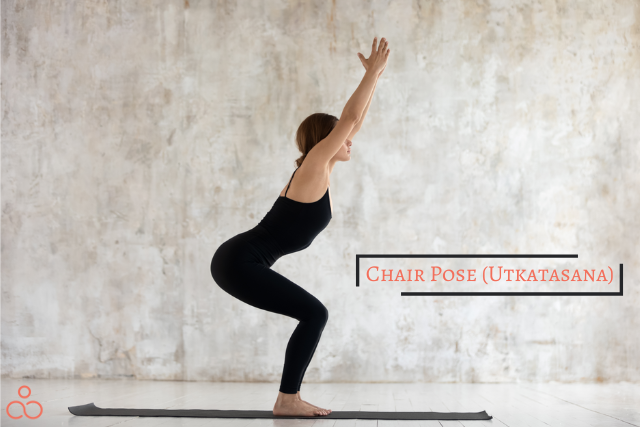
Camel pose
Kneel on all fours with your hands on the floor next to you; press your abdominal muscles inward and lift your chest to straighten your back. Hold for a few seconds, then slowly lower yourself back to the starting position.
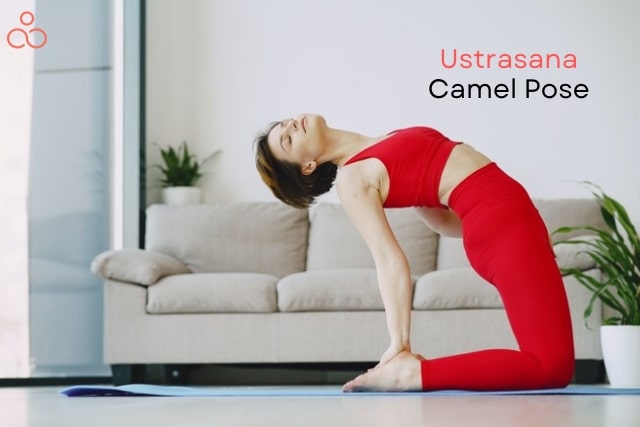
Warrior I pose
While standing with your feet hip-width apart, bend your knees and stretch out your left arm parallel to the ground. Reach overhead with your right hand and touch your shoulder with your fingertips. Engage your core and extend both legs simultaneously in alignment from your head to your toes. Hold this pose for a few seconds before switching legs. Focus on your breathing and keep your core engaged throughout the exercise.
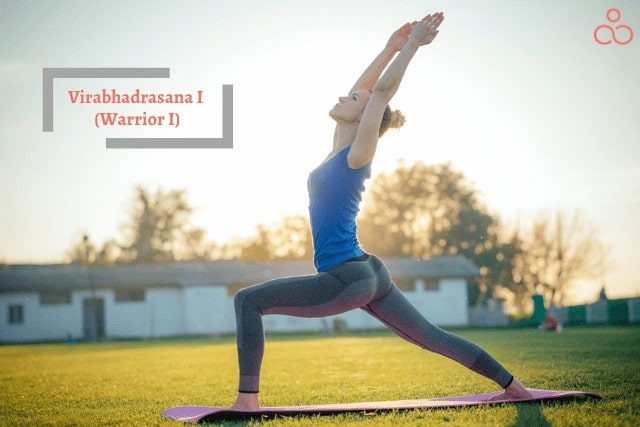
Warrior II pose
Begin by standing with your feet roughly 3 – 4 feet apart. Rotate your right foot outwards and your left foot slightly inwards. Slowly bend your right knee and extend your arms straight out to the sides, keeping them at shoulder height. Hold this pose for several deep breaths, then switch to the other side.
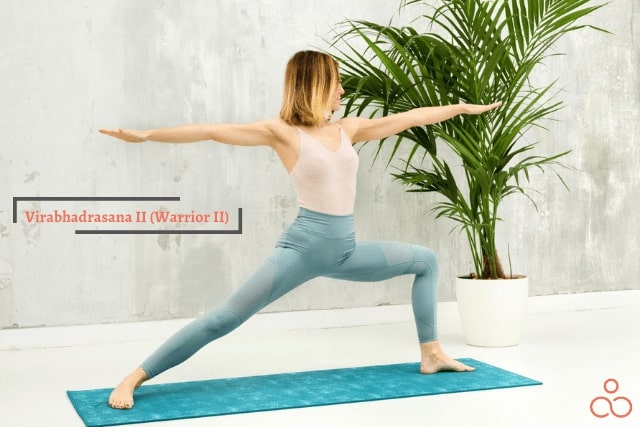
Pigeon pose
Lie on your back and place your hands on the floor beside you. Press your feet toward the ceiling, tuck your chin under your chest, and lift your hips off the floor. As you exhale, lean back until your forehead touches the floor. Hold a few breaths, then press your heels into the floor and rise back onto your hands and knees.
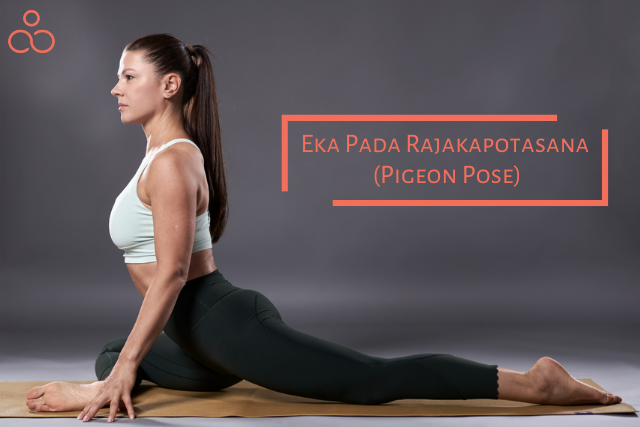
Child’s pose
Start by getting down on your hands and knees. Then, slowly lower your hips back towards your heels while simultaneously extending your arms forward. Take a deep breath and rest your forehead on the ground.
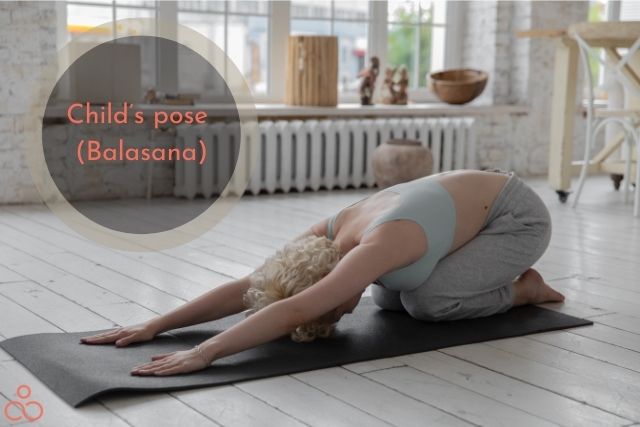
Downward Facing Dog pose
Begin in the table-top position with your hands and knees on the ground. Push your hips up and back, lengthening your spine while exhaling. Continue to press your hands and feet into the floor, and take several deep breaths in this pose.
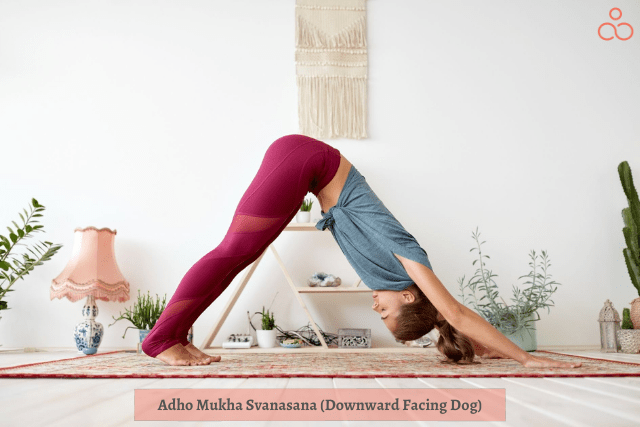
Tree pose
Stand with your feet together, then bring your right foot to the inside of your left thigh, pressing your foot into your thigh and your thigh into your foot. Bring your hands to your heart, hold for several breaths, and switch sides.
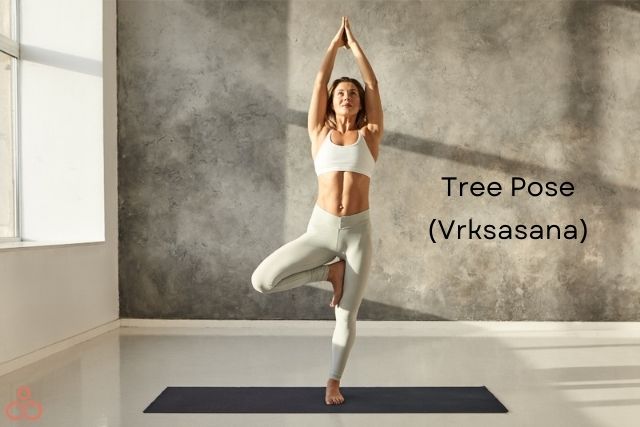
Feel free to experiment with easy yoga poses and modify them to suit your needs. Always listen to your body and only do what feels good. Have fun practicing!
A Useful Guide on Choosing the Right Yoga Mat for Carpet
Choosing the proper yoga mat for carpeted floors is crucial. Standard mats might not offer the grip and cushion you need. Opt for a mat specifically made for carpeted surfaces to ensure safety and comfort during your practice. This yoga mat allows smooth movement on carpets without compromising stability. While it may not be the cheapest option, it’s a valuable investment, especially for dedicated yogis.
Important tips for finding your perfect carpeted yoga mat
Good Traction
Yoga mats can quickly move and slide on carpets, so looking for mats with a good grip or texture on both the top and bottom are essential. This will help to keep them in place, primarily if you practice a faster-paced vinyasa style. You can also use a non-slip rug pad underneath your mat to reduce the risk of slipping and sliding.
Thickness
Choosing a mat that is thick enough to provide ample cushioning and support is important for carpeted surfaces. Look for mats that are at least 1/4 inch thick.
Material
Mats made from natural materials like rubber or jute tend to grip better on carpeted surfaces than synthetic ones like PVC. However, some people may have allergies or sensitivities to natural materials, so consider this factor carefully.
Texture
Mats with textured surfaces can help prevent slipping and sliding on carpeted surfaces. Look for mats with a slightly rough or sticky texture for added stability.
Size
Consider the size of your practice space when selecting a mat. A larger mat may provide more room for movement, but be sure it fits comfortably in your space.
Durability
Choosing a durable mat is important for frequent use on carpets. Look for a mat that can withstand wear and tear and won’t break down easily.
Easy Maintenance
Since carpet can hold onto sweat, dirt, and bacteria, choosing a mat that is easy to clean is important. Look for a mat that can be wiped down with a damp cloth or machine washed.
By considering these factors and your personal preferences, you can ensure that you choose the perfect yoga mat for your carpeted practice space. Happy stretching!
Avoid These common mistakes while practicing yoga on a carpet!
Yoga can be an excellent way to stay active and centered, but practicing on the carpet can present some challenges. To get the best out of your practice sessions, here are some common mistakes you should avoid:
Slipping and sliding
To prevent slipping and sliding, make sure your mat has good traction, and consider wearing grip socks. Also, avoid practicing on a heavily padded carpet or one with a lot of texture.
Overstretching
When doing yoga on a carpet, it’s crucial to be mindful of your stretching. Carpets provide more cushioning than hard floors which can lead to over-stretching and potential injury. Always remember to maintain proper alignment and pay attention to your body’s limits.
Uneven surface
Carpets can often have bumps or lumps, affecting your balance and alignment. Make sure to choose a flat and even surface to practice.
Use a yoga mat instead of a carpet
While it may seem convenient to use a carpet for your yoga practice, it doesn’t offer the same level of support and grip as a yoga mat. A yoga mat will prevent you from slipping, help cushion your joints, and provide a stable surface for your practice.
Hygiene
Carpets can be home to a lot of dust, dirt, and bacteria, so make sure to clean your yoga mat regularly and consider using a towel on top of the carpet for added hygiene.
Lack of support
Carpets can provide less support for your joints than a yoga mat or hard floor. Be sure to use props like blocks, straps, or blankets to support your body, deepen your stretches, and prevent injuries.
Be mindful of your alignment
When practicing on a carpet, losing sight of your alignment is easy, as the uneven surface can throw you off balance. Make sure to keep a strong foundation by grounding down through your feet and engaging your core.
By keeping these tips in mind, you can practice yoga on a carpet efficiently and effectively.
Important Tips by Yoga Experts!
- Take your time doing stretches.
- Focus on taking smooth, continuous breaths throughout the pose.
- Be mindful of your positioning; if something feels off, let go and experiment with another pose until you find one that is comfortable and safe.
- Use caution when stretching the spine.
- Avoid jerking or twisting your body unnecessarily.
- If you feel pain or discomfort, stop immediately and seek medical attention.
Did you know?
- Interestingly, yoga mats were invented in the 1960s. Before yoga mats came about, ancient practitioners practiced yoga on grass or a rug made of animal skin. The need for better cushioning arose when yoga poses started becoming more challenging. People then began using cotton towels, which eventually evolved into rugs made of synthetic cloth.
- In the 1960s, German yogi Angela Farmer tried using a foam carpet underlay in her practice, and the modern yoga mat was born. It then became every yoga practitioner’s best friend.
- Some yoga practices in Scandinavia use cotton futon mats. However, they tend to be expensive.
FAQ’s
Is it possible to do yoga on a carpet?
Yes, it is possible to do yoga on a carpet. The essential factor is to ensure that the carpet is clean and free of any obstacles. You can also consider using a yoga mat on top of the carpet for added stability and cushioning.
Can you use a Lululemon yoga mat on a carpet?
Using a Lululemon yoga mat on a carpet is OK. Reversible 5mm mats are thick enough to offer a stable base for your practice, mainly if you use them.
Furthermore, its rubber base can provide sufficient traction to keep you from slipping over your carpet during practice.
Is it better to do yoga on a carpet?
It is not ideal to do yoga on a carpet since it doesn’t provide a stable and supportive surface, which can lead to improper alignment, imbalanced postures, and an increased risk of injury due to slipping or lack of grip. Using a yoga mat on a flat, non-slippery surface is recommended for optimal grip and comfort.
Can I use a rug instead of a yoga mat?
Yes, a rug can be used as a yoga mat. Many people use rugs, towels, or blankets as yoga mats if they still need a dedicated yoga mat.
Choosing a rug or towel that is large enough to support your entire body and provide a comfortable, stable surface for practicing yoga is essential.
How thick should a yoga mat be on a carpet?
A typical yoga mat thickness is 3 to 4 millimeters or 1/8 of an inch, which is ideal for hard surfaces but too thin for carpets or rugs because they are more prone to slipping and wrinkling. For a better grip, the mat should be aligned approximately 6 millimeters from the edge of the carpet.
What are some alternative yoga mat options for practicing yoga on a carpet?
While doing yoga on a carpet, using a mat is optional. It’s vital to find what’s comfortable for you, keeping in mind the ultimate goal is achieving inner peace. Feel free to explore other yoga mat alternatives for a better experience. Here are some of them:
- A quilt
- Old thick blankets
- Yoga mats at home
- Beach towel
- Rug or carpet
How do you keep a yoga mat on a carpet?
There are two ways to stabilize a yoga mat on a carpet.
- The first method uses a thick yoga mat, has a good grip (tops and bottom), and is made of sturdy material.
- Using a non-slip rug gripper is the alternative method. This will ensure that your yoga mat remains in place while you practice.
How to do yoga on carpet thats too soft?
Here are some tips for practicing yoga on a soft carpet:
- Roll out a yoga mat or towel to create a stable surface.
- Distribute your weight evenly to avoid sinking into the carpet.
- Focus on slow and intentional movements to maintain balance.
- Use props such as blocks or straps for additional support.
Conclusion
Even though it can look intimidating to do yoga on the carpet when you first start, the truth is that carpet-based yoga can bring plenty of comforts and is a great way to stay active and healthy in the comfort of your home.
To make sure you’re getting the most out of the practice, it’s essential to purchase a mat that is well-secured to the carpet to provide the necessary support to your pose. By following proper technique and having the right tools on hand, carpet-based yoga can be enjoyed safely and comfortably.
Hopefully, this article has given you some insight into the possibilities of carpet-based yoga and helps you to start practicing at home.
Namaste!

